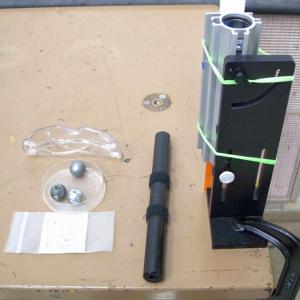College of Liberal Arts & Sciences
1M40.65 - Spring Gun and Balls of Different Mass
Set the spring gun to the desired spring compression position. There are three different positions to chose from. Observe that different mass balls will go to different heights at the same spring compression setting. We usually use the 2nd notch of compression for this demo.
The cup in the spring gun that the ball sits in has a mass of 56.5 g that must be added to the mass of the ball when doing the situation where a ball of half the mass will go twice as high. So for that situation we have two balls that are to be used which have masses of 15 g and 86.6 g. Adding in the mass of the cup gives you: 56.5 g + 15 g = 71.5 g, and 56.5 g + 86.6 = 143 g, or a 1:2 mass ratio that the spring is pushing.
- Borislaw Bilash II, David Maiullo, "Spring Ball", A Demo a Day: A Year of Physics of Demonstrations, p. 87.
Disclaimer: These demonstrations are provided only for illustrative use by persons affiliated with The University of Iowa and only under the direction of a trained instructor or physicist. The University of Iowa is not responsible for demonstrations performed by those using their own equipment or who choose to use this reference material for their own purpose. The demonstrations included here are within the public domain and can be found in materials contained in libraries, bookstores, and through electronic sources. Performing all or any portion of any of these demonstrations, with or without revisions not depicted here entails inherent risks. These risks include, without limitation, bodily injury (and possibly death), including risks to health that may be temporary or permanent and that may exacerbate a pre-existing medical condition; and property loss or damage. Anyone performing any part of these demonstrations, even with revisions, knowingly and voluntarily assumes all risks associated with them.


